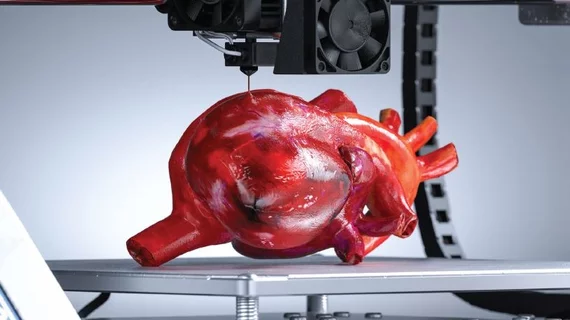3D printing use in radiology saves an estimated 41 minutes, $2,500 per case
The use of 3D printing in radiology saves an estimated 41 minutes or $2,500 per case, according to new data shared Aug. 6 in the Journal of the American College of Radiology [1].
Clinical 3D printing has grown rapidly in recent years, serving a wide range of applications. However, there is a lack of systematic data on how the technology is used in regular practice—information that could be used for benchmarking and improving regular practice.
With this in mind, ACR and the Radiological Society of North America in June 2020 launched a registry aimed at collecting standardized data on 3D printing performed in healthcare facilities. Researchers took a closer look at this information, sharing their insights on Tuesday.
“Clinical 3D printing performed in healthcare facilities is utilized for patients of all ages and for a wide range of clinical indications,” lead author Kenneth C. Wang, MD, PhD, with the University of Maryland School of Medicine’s department of radiology, and colleagues concluded. “Registry data provides insight into the technologies and workflows used to create anatomic models and guides, and clinical users report benefits from 3D printing including increased confidence and shortened procedure times.”
Data spanned the three years ending in June 2023, covering 20 care sites and over 2,600 cases. Most commonly, patient models were used in cardiac care, while 3D guides were deployed primarily in neurological cases (42%). CT was used across about 88% of instances, while MRI was deployed in 22% (more than one imaging modality may be used for a given case). Among 11 organ systems reported, neurologic, cardiac, musculoskeletal, breast and genitourinary were most common, accounting for 93% of all cases.
In terms of time spent, radiologists and other healthcare providers allocated about 34 minutes toward consultations, 32 minutes on segmentation, 21 minutes on computer-aided design, and 6 minutes on preparation/post-processing. The average total time expended per 3D printing case was 92.4 minutes for providers and 335 minutes for other nonproviders (e.g., technologists, engineers and scientists). These times correspond to an estimated provider effort cost of about $339 and $267 for other members of the care team, or a total of almost $606 per case on average.
Not all 3D printing cases were performed in preparation for a surgical procedure, the authors noted. However, for the small subset that did report this data (about 155 instances), Wang et al. estimated that 3D printing saved providers an average of nearly 41 minutes, with operating room costs saved of about $2,511 (using an estimated OR cost of $62 per minute). That far exceeds the staffing cost of $606 by a fourfold factor, the authors noted.
“The savings estimate is also subject to several important limitations,” the authors cautioned. “First, this estimate is based on time savings reported in 5.9% of cases in the study. Not all 3D printing cases are performed in preparation for an operative procedure, and this savings estimate cannot be generalized to all 3D printing cases. Second, it is likely that some cases which did not report a procedure time savings were nonetheless used in preparation for an operative procedure, and the estimate does not include these cases. Third, the time savings reported were subjective estimates provided by users based on their clinical experience, rather than measured procedure times. Fourth, operating room costs vary considerably between institutions. Furthermore, some of the estimates obtained may relate to nonsurgical procedures, such as procedures performed in a cardiac catheterization laboratory rather than an operating room, and these other procedural suites have different cost structures. However, despite these limitations, the cost savings estimate presented here is consistent with other reported estimates.”
Read more in JACR at the link below.

